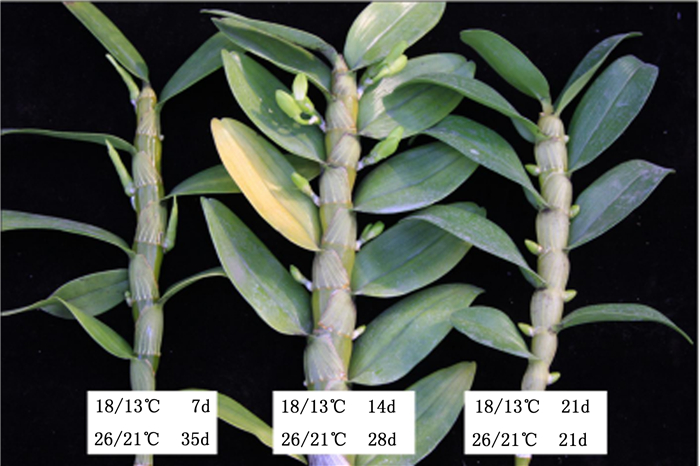-
石斛兰(Dendrobium)为兰科附生兰类[1],与卡特兰(Cattleya)、蝴蝶兰(phalaenopsis)、文心兰(Oncidium)并列为观赏价值最高的“四大观赏洋兰”[2]。按照开花时间和形态特征不同,石斛兰可以分为春石斛兰和秋石斛兰[3]。我国20世纪90年代引进春石斛兰,栽培规模一直呈上升趋势,春石斛兰盆花与切花生产具有广阔的前景。目前对于春石斛兰的花期调控研究比较多,但不同研究者得出的结论不同,有的研究认为春石斛兰花芽分化需要低温刺激[4],但也有研究认为在高温下春石斛花芽才能分化[5]。准确地了解春石斛兰花芽分化的规律和影响因素,可以为制定合理的栽培和管理措施提供一定的理论依据,同时研究不同的温度处理对春石斛兰花芽分化和发育的影响,探讨不同温度与石斛兰花芽分化和发育的关系,为石斛兰的生产栽培提供技术支持。
HTML
-
试验于2012—2015年进行,供试品种为Den. Spring Snow,采用从高芽繁殖的2年生健壮植株,栽培管理于中国林业科学研究院科研温室内。
处理A,2012年10月15日搬入人工气候箱开始进行处理;仪器为RXM(浙江宁波产)智能气候箱,分别进行26/21℃(昼/夜温度,下同)、22/17℃、18/13℃的处理,光周期设定为光照12 h,黑暗12 h,光强320 μmol·m-2·s-1,空气湿度70%~80%;每个处理24盆,12月10日停止处理。从第5节叶腋处开始取芽,每7 d取样一次,每次取芽20个,取下芽体后迅速置于FAA固定液中,按常规石蜡制片,切片厚度8~10 μm,番红—固绿对染,加拿大树胶封片,Olympus BH-2型显微镜观察、拍照。
处理B,进行高温—低温—高温处理,2013年10月12日搬入人工气候箱开始进行处理,先高温26/21℃处理14 d,再转移到18/13℃,经过7、14、21、28、35 d处理,然后再转到26/21℃处理35、28、21、14、7 d,每个处理24盆。12月5日停止处理。除了试验因素外,其他管理措施相同。
处理C,进行低温—高温处理,2014年10月12日先低温18/13℃处理过7、14、21d处理,再转到26/21℃处理35、28、21 d,共处理42 d,11月23日停止处理。每个处理24盆,除了试验因素外,其他管理措施相同。
-
石斛兰叶腋处的休眠芽,从开始萌动到转向生殖生长,到整个花序形成,大致可划分为以下7个时期。
-
休眠期(Dormant phase, DP)此时芽体小,呈高圆丘状,细胞形状相似,个体较小,排列紧密,整个芽体染色均匀(图版,1)。
-
萌动期(Germination phase, GP)芽体还是呈高圆丘状,但生长锥顶端分生组织细胞排列紧密,细胞核大,染色较深,而下部的芽基组织细胞较大,核较小,排列疏松,不规则(图版,2)。
-
花序原基分化期(Inflorescence Primordium Differentiation Phase, IPDP)生长点先变得圆滑肥大,向上隆起,呈半球形,生长点下面的细胞大而圆,排列疏松(图版,3)。
-
花蕾原基分化期(Flower Differentiation Phase, SFDP)在不断膨大的生长锥下部周围隆起并逐渐分化产生1 ~ 3个椭圆形突起,即为花蕾原基。随后,中央顶端突起逐渐由圆扁变扁平,形成总状花序的顶花原基,其下部的突起形成花序中其它的侧花原基,呈椭圆形。此时,石斛兰的总状花序已现雏形(图版,4~5)。
-
萼片原基分化期(Sepal Differentiation Phase, SDP)花蕾原基进一步增大变宽,继而在周围产生突起(切片上为两边突起),此突起即为萼片原基。侧蕾萼片原基生长很快,随后顶花原基也膨大变粗,顶部凹陷,其分化速度稍落后于侧蕾原基(图版,6~7)。
-
花瓣原基分化期(Petal Differentiation Phase, PDP)随着萼片原基的不断分化生长,在伸长的萼片原基内侧产生新的凸起,即为花瓣原基(图版,7~9)。花瓣原基分化与萼片原基分化重合,分化时间快。
-
合蕊柱分化期(Column Differentiation Phase, CDP)在花瓣原基继续生长发育的过程中,不断生长伸长的花瓣原基内侧又分化出新的凸起(图版,10),分化出合蕊柱原基。此时萼片己基本形成,抱合紧密,唇瓣开始逐渐覆盖于合蕊柱之上(图版,11~12)。至此,整个花芽形态分化过程结束。
-
由表 1和图 1可以看出,在高温26/21℃处理条件下,从处理开始一直到处理结束,石斛兰芽体一直处于休眠芽状态,不能完成花芽分化;在22/17℃处理条件下,14 d后石斛兰芽体开始萌动,第21 d时大多数还是处于萌动期,但已经有芽体开始进入花序原基分化期,此后萼片分化期和花瓣分化期较快,基本14 d就能完成,合蕊柱分化期历时比较长,要经历14 d左右,在处理的第56 d,花芽分化完成。在18/13℃条件下,7 d后就进入萌动期,14 d后花序原基形成,此后花芽分化较快,35 d就能完成花芽分化。
处理时间
Treat/d处理温度(白/夜) Temperature (Day/Night) /℃ 26/21 22/17 18/13 7 DP DP DP: GP=2:3 14 DP DP: GP=7:3 IPDP: FDP=3:1 21 DP GP: IPDP=4:1 FDP: SDP: PDP: CDP=1:3:2:1 28 DP IPDP: FDP=2:3 SDP: PDP: CDP=1:3:6 35 DP FDP: SDP=2:3 CDP 42 DP SDP: PDP: CDP=1:7:2 49 DP PDP: CDP=1:4 56 DP CDP 注:DP、GP、IPDP、FDP、SDP、PDP、CDP分别代表休眠期、萌动期、花序原基分化期、花蕾原基分化期、萼片原基分化期、花瓣原基分化期、合蕊柱分化期。
Note: DP、GP、IPDP、FDP、SDP、PDP、CDP means Dormant phase, Germination phase, Inflorescence Primordium Differentiation Phase, Flower Differentiation Phase, Sepal Differentiation Phase, Petal Differentiation Phase, Column Differentiation Phase.Table 1. Statistics on flower bud differentiation of Den. Spring Snow under different temperature
-
在高温26/21℃处理2周条件下,石斛兰花芽不能分化。从高温转到低温,接受低温18/13℃处理7 d,再接受高温处理,花芽不能完成分化,芽体分化为营养芽(图版,13~14),最终形成高芽;经过14 d低温处理后再接受高温处理,能够完成花芽分化,而且在高温条件下花芽分化生长迅速,在第42 d时,已经可以显现完整花蕾状态;在经过低温18/13℃处理21 d、28 d、35 d后,再接受高温处理,都能够完成花芽分化,但随着低温处理的时间越长,花芽生长发育速度变缓, 在高温处理下,花芽分化和生长速度会加快(图 2)。
-
经过低温18/13℃处理7 d,再经过高温26/21℃处理,春石斛兰不能完成花芽分化,最终形成高芽;经过低温14 d、21 d处理,再经过高温26/21℃处理,春石斛兰能够顺利完成花芽分化,最终形成花蕾。同样发现,低温处理时间越长,花芽生长发育速度变缓, 在高温处理下,花芽分化和生长速度会加快(图 3)。
2.1. 石斛兰花芽分化时期及主要特征
2.2. 不同温度处理对花芽分化的影响
2.2.1. 不同温度处理对花芽分化的影响
2.2.2. 高温—低温—高温对石斛兰花芽分化和发育的影响
2.2.3. 低温—高温处理对石斛兰花芽分化和发育的影响
-
石斛兰的花芽分化过程与蝴蝶兰[6]、卡特兰[7]基本相似,都是逐步分化出花序原基、花蕾原基、萼片原基、花瓣原基,随后又因兰花其特殊的生理构造,开始其特有的繁殖器官发育过程—合蕊柱的发育,但是石斛兰与蝴蝶兰和卡特兰有一个明显的不同点,那就是存在萌动期阶段,当经历7 d的18/13℃低温处理后,芽体就处于萌动期状态,这是一个对温度高度敏感的时期,此后的温度高低决定芽体分化的走向。如果此段时间石斛兰经历18/13℃的低温诱导,能够促进花芽分化;如果此段时间石斛兰遭遇高温,则形成高芽。
有研究表明,热带兰由营养生长转向生殖生长的重要环境信号是温度[8],温度过低或过高都会抑制花芽的分化和发育。蝴蝶兰(Phal. hybrida)[9-10]、卡特兰(C. hybrida)[11-12]、大花蕙兰(Cymbidium hybridum)[13]等热带兰需要在一定的时期内接受某种程度的低温诱导才能成花,若低温处理不足,会导致开花整齐度差,甚至不能完成花芽分化,而且花芽分化有一定的温度上限,如蝴蝶兰所在环境日温大于28℃,花芽几乎不会发生[9],大花蕙兰在35/25℃的温度条件下,花芽的形成受抑制[13],卡特兰在35/30℃的高温处理下能够延迟或抑制开花[11-12]。本研究也表明,在高温26/21℃处理条件下,石斛兰不能完成花芽分化,22/17℃处理条件下,需要56 d才能完成花芽分化,在18/13℃条件下,35 d能够完成花芽分化,可见,石斛兰花芽分化过程持续时间和温度有关,温度低,花芽分化速度越快。
持续足够时间的低温是花芽分化的关键,石斛兰在18/13℃低温处理14 d就可以完成花芽分化的启动,花芽分化开始后,不管是经历高温还是低温,花芽分化都能够继续进行,在较高温度条件下下,花芽分化和生长速度会加快。在生产中可以利用这一特点对春石斛的花期进行调控,首先至少经历14 d的持续低温处理,再根据目标花期时间对春石斛进行高温或低温处理。
-
持续足够时间的低温是花芽分化的关键,萌动期是一个对温度高度敏感的时期,此时至少经历2周的低温,能够形成花芽,经历高温,则形成高芽。花芽形成后温度高有利于花芽的发育。

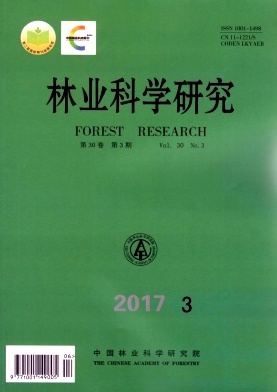


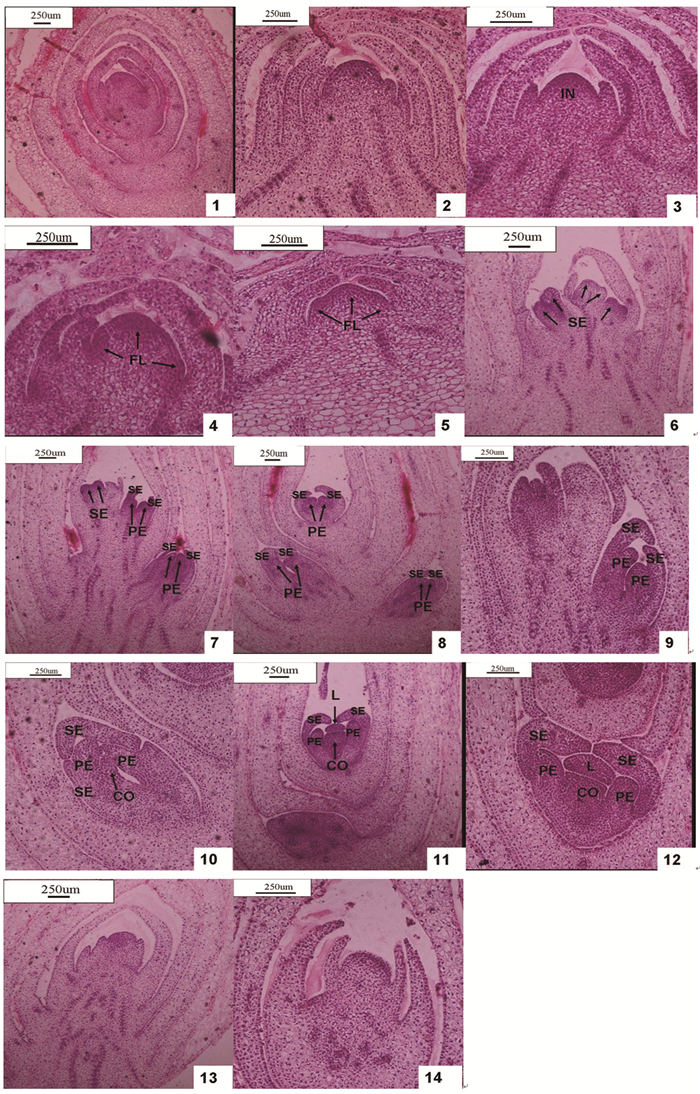

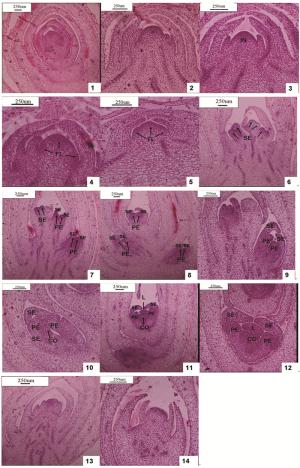
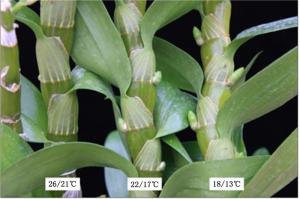


 DownLoad:
DownLoad:


